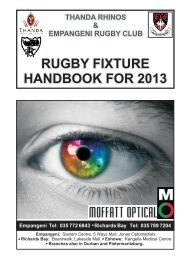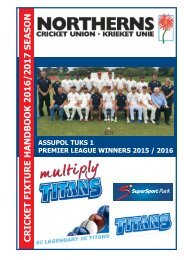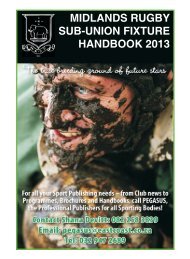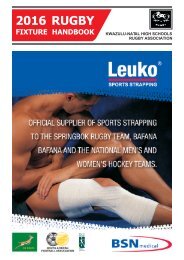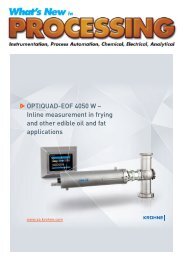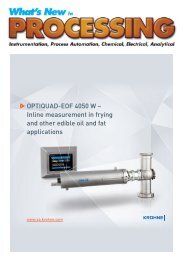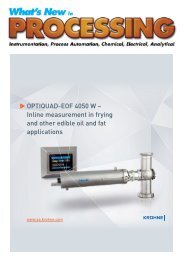Gauteng Cricket Board Blue Book
Create successful ePaper yourself
Turn your PDF publications into a flip-book with our unique Google optimized e-Paper software.
PLAYING CONDITIONS:<br />
SENIORS 35 OVER COMPETITION (Six Leagues)<br />
Subject to the provisions of these conditions, the Laws of <strong>Cricket</strong> and the By-Laws and General Regulations of the<br />
<strong>Board</strong> shall apply. Team Sheets are to be completed no later than 15 minutes before the start of the match and<br />
the toss may only take place once they have been exchanged. The team arriving late or the latest will forfeit the toss.<br />
The captains must notify the umpires and the opposing captain of the age group of all players participating in an adult<br />
match who are in the under 19 age group or younger, even if the player is not a fast bowler. This requirement also covers<br />
any young player taking the field as a substitute fielder. The captains must also make sure that they are aware of all the<br />
restrictions and safety measures relating to these junior players as reflected in the By-Laws and General Regulations.<br />
1. Hours of Play:<br />
The hours of play shall be:<br />
10:00 to 12:25 One 5-minute drinks break after 17 overs<br />
12:25 to 13:05 Luncheon Interval<br />
13:05 to 15:30 One 5-minute drinks break after 17 overs<br />
2. The Ball:<br />
Only a new 2-piece GCB ball or a 2-piece Platypus Red Thunder/Googly Longlife ball can be used. Any variation from the<br />
prescribed ball will not stop the match from taking place, the umpires will record the ball used on the result card and the office<br />
will take appropriate action at a later time.<br />
3. Fielding restrictions:<br />
Two semi-circles shall be drawn on the field of play. The semi-circles shall have as their centre the middle stump at either<br />
end of the pitch. The radius of each of the semi-circles shall be 30 yards (27.43 metres). The semi-circles shall be linked by<br />
two parallel straight lines drawn on the field. The fielding restriction areas should be marked by continuous painted white<br />
lines or dots at 5 yard (4.57 metres) intervals, each dot to be covered by a white plastic or rubber (but not metal) disc<br />
measuring 7 inches (18 cm) in diameter. A Maximum of 5 players are allowed outside the circle.<br />
No more than 5 players are allowed on the leg side.<br />
4. Bowling restrictions:<br />
No bowler to bowl more than 7 overs<br />
th<br />
In the event of a reduced innings, no bowler to bowl more than 1/5 of the available overs. If the remaining overs are not<br />
divisible by 5, one additional over shall be allowed to the maximum number per bowler to make up the balance.<br />
5. Wide Deliveries:<br />
A line shall be drawn, 17 ins / 43.18 cm in from the Return Crease, and shall extend 30 cm back from the Popping Crease,<br />
and 30 cm forward from the Bowling Crease. This line must be used to adjudge off-side wides only.<br />
Umpires are instructed to apply very strict and consistent interpretation in this regard in order to prevent negative bowling<br />
wide of the wicket. Any leg-side delivery which in the opinion of the umpire does not give the batsman a reasonable<br />
opportunity to score shall be called a wide. For a spin bowler the length of the delivery must be taken into consideration.<br />
A penalty of one run for a wide shall be scored. The penalty shall stand in addition to any other runs which are scored or<br />
awarded. All runs, which are run or result from a wide ball, which is not a no ball, shall be scored as wide balls.<br />
6. Short-Pitched Deliveries:<br />
One short-pitched delivery shall be allowed per over, adjudged as having passed over the batsman's shoulder standing<br />
upright at the crease.<br />
In the event of a second short pitched delivery in the over, the umpire, after the call and signal of “no ball” and when the ball is<br />
dead, shall caution the bowler, and advise the relevant parties. This caution shall remain in force for the duration of<br />
the innings.<br />
If there is a further infringement by the same bowler, the umpire, after the call and signal of “no ball”, and when the ball is<br />
dead, shall instruct the captain to take the bowler off. He shall not bowl again in the innings. The over shall be completed<br />
by another bowler who is eligible to bowl.<br />
7. Length of innings:<br />
In the event of the side bowling first not completing its required number of overs by the scheduled (or rescheduled) close,<br />
they shall be required to face the number of overs bowled at the schedule (or rescheduled) close of the first innings;<br />
E.g. 33 overs bowled at the scheduled close they shall continue to bowl the remaining overs, but shall only face<br />
33 overs when batting.<br />
8. Luncheon Interval:<br />
Shall be taken between innings, and shall be for 40 minutes duration.<br />
In the event of the innings of the side batting first finishing 30 minutes, or earlier, than the scheduled time for lunch, the<br />
second innings shall commence (after a 10 minute change of innings), and shall continue until the scheduled time for lunch.<br />
9. Drinks Break:<br />
There shall be one drinks break allowed per innings, taken on the field of play, after 17 overs have been bowled. In the event of<br />
A reduced innings the umpires shall use their discretion as to the timing of the drinks interval. The drinks break shall not exceed<br />
5 minutes. An allowance will be made in respect of the drinks break for calculating the over rate of an innings.<br />
GAUTENG CRICKET BOARD BLUE BOOK 2016/2017 SEASON 45




